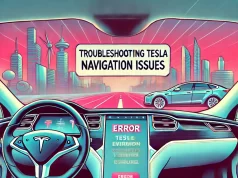Regenerative braking allows Tesla vehicles to recharge their battery while slowing down, which can improve energy efficiency and increase the range of the vehicle.
However, sometimes Tesla owners may encounter a situation where their regenerative braking system does not work as expected. They may see a notification on the screen that says “Regenerative Braking Temporarily Reduced” or “Regenerative Braking Limited”.
This can be worrying, especially for new Tesla owners who are not familiar with how the system works.
However, there may be instances where regenerative braking stops working, leaving Tesla owners to wonder what went wrong.
In this article, we will explore the functionality of regenerative braking and possible reasons why it may not be working.
Why Regenerative Braking May Stop Working?
One common reason is that the battery is already fully charged. Regenerative braking works by storing excess energy in the battery, so if the battery is already at its maximum capacity, the system will not be able to recover any more energy.
In this case, regenerative braking will not work until the battery is discharged.
Another reason why regenerative braking may stop working is due to a fault in the brake system.
If the brake pads are worn out or the brake system is malfunctioning, the vehicle may not be able to slow down or stop properly, and regenerative braking may be disabled as a safety precaution.
Tesla vehicles are equipped with sophisticated software that controls various aspects of the vehicle, including regenerative braking. If there is a problem with the software, it may disable regenerative braking or cause it to malfunction.
In this case, the vehicle may need to be reset or the software may need to be updated.
How to Fix Tesla Regenerative Braking Issue?
Method #1: Get Your Tesla Warmed
One of the most common reasons why Tesla’s regenerative braking does not work is cold weather conditions. When the battery temperature is below 68 degrees F (20 degrees C), the regenerative braking system will be limited or reduced.
This is because it is difficult to charge the battery when it is cold, and charging it too fast can damage it.
The solution to this problem is to drive the car normally until the battery warms up. As soon as the temperature rises above 68 degrees F (20 degrees C), the regenerative braking system will resume its normal function.
Alternatively, you can use the pre-conditioning feature on your Tesla app to warm up the battery before you start driving.
Method #2: Discharge Your Tesla
Tesla’s regenerative braking does not work when the battery is fully charged or close to 100%. In this case, there is no room for the battery to store more electricity from the regenerative braking system.
Therefore, the system will be disabled or limited to prevent overcharging.
The solution to this problem is to avoid charging your battery to 100% unless you need it for a long trip. Instead, you can set a lower charging limit on your Tesla app, such as 80% or 90%, depending on your daily driving needs.
This way, you will leave some space for the regenerative braking system to work and extend your battery life.
Method #3: Driving Conditions
The third reason why Tesla regenerative braking does not work is related to the driving conditions. For example, if you are driving on a highway at high speed and do not apply frequent brakes, the regenerative braking system will have less opportunity to work.
Similarly, if you are driving downhill or on a slippery road, the regenerative braking system will be limited or reduced to prevent skidding or losing control.
The solution to this problem is to adjust your driving style according to the road conditions. For example, you can use the low or standard regenerative braking mode instead of the high mode when driving downhill or on a slippery road.
You can also use the brake pedal when needed to supplement the regenerative braking system.
Conclusion
Regenerative braking is a key feature of Tesla vehicles that allows them to recover energy while slowing down. However, there may be instances where regenerative braking stops working, which can be concerning for Tesla owners.
By understanding how regenerative braking works and the possible reasons why it may stop working, drivers can troubleshoot the issue and get their vehicle back on the road. If all else fails, contacting Tesla customer support may be necessary to get the problem resolved.




